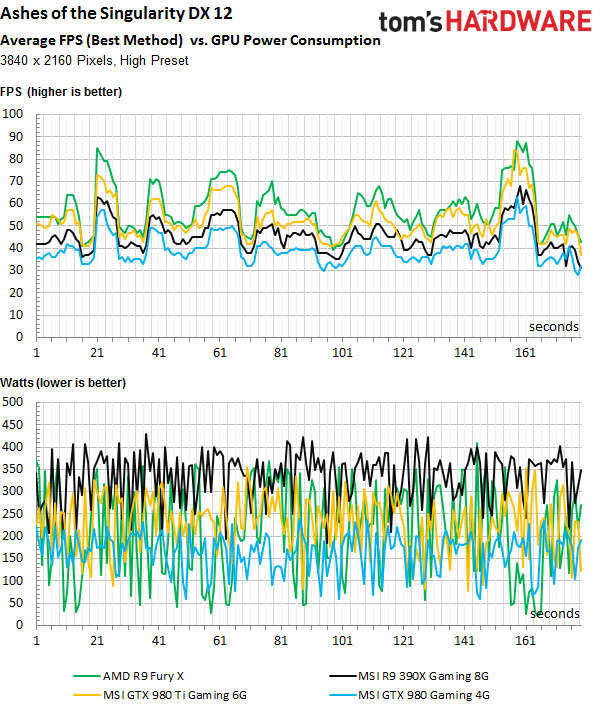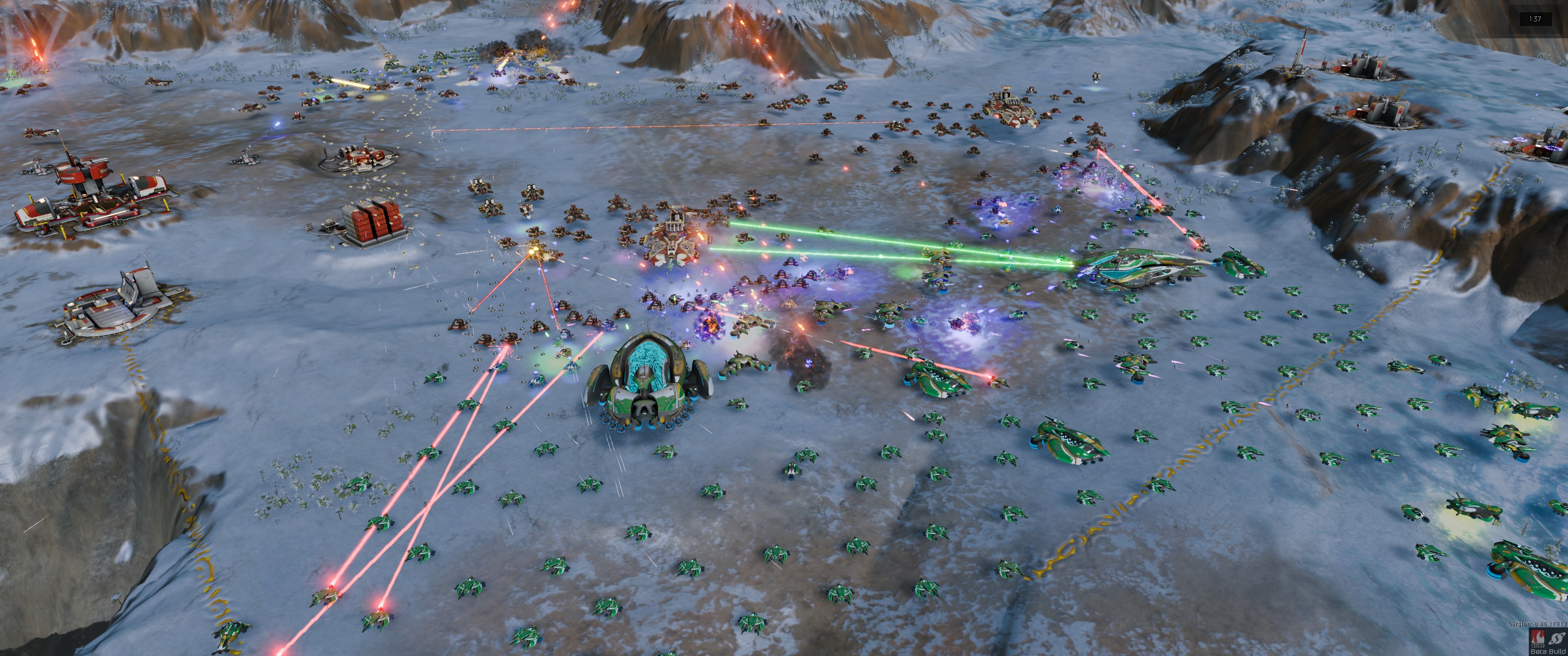Ashes Of The Singularity Beta: Async Compute, Multi-Adapter & Power
DirectX 12 has been available since Windows 10, but there aren't any games for it yet, so we're using the Ashes of the Singularity beta to examine DX12 performance.
DX12 vs DX11 GPU & CPU Power Consumption
Graphics Card Power Consumption
We chose the four fastest cards that aren't too GPU-limited in Ultra HD, and measured their power consumption for all three render paths.
While the Radeon R9 Fury X adheres to its power limit, the Radeon R9 390X under DirectX 12 blows through the roof compared to DirectX 11. Its 100W-higher power consumption with asynchronous compute activated may be okay when you consider the 20 percent performance increase, but it's just marginally less with this option deactivated, despite significantly lower framerates.
Both Nvidia cards demonstrate increased power consumption with just a moderate performance boost. The GeForce GTX 980 Ti buys itself a mere three frames per second at the cost of 45W+. The GeForce GTX 980, on the other hand, stays rather inconspicuous.
Power Consumption Of The CPU
Of course, we also measured the CPU's behavior. These values were measured over the full benchmark run and contain no VRM losses. Regardless of the graphics card, CPU power consumption drops, particularly when we test with one of Nvidia's boards.
A Look At Efficiency
To draw a more informed conclusion, we add the CPU's and GPU's power consumption. After all, a real efficiency analysis is only possible by looking at the big picture of the individual interactions.
The Radeon R9 390X is really fast under DirectX 12, but consumes a lot of power and lags far behind, resulting in its last-place finish, efficiency-wise.
A Look At The Details
Now we're looking at the corresponding CPU and GPU power consumption values based on their framerate curves over time:
Get Tom's Hardware's best news and in-depth reviews, straight to your inbox.
You can see that the Radeon R9 Fury is throttling partially, while the Radeon R9 390X continues to churn along with red-hot glowing wheels.
The CPU power consumption over time, on the other hand, is less spectacular.
Troubleshooting
Before we draw our final conclusions, we’d like to mention that running the Ashes of the Singularity benchmark wasn’t exactly an easy endeavor. In fact, there was a lot of troubleshooting involved, which cost us a lot of time. The multi-GPU part was particularly problematic, and it seems that this wasn’t just the case for us. Many of our colleagues experienced the same problems. One major drawback of Ashes of the Singularity as it stands is the game’s inability to run in true full-screen mode. Instead, it uses a borderless window as its only option.
This makes the Ashes of the Singularity benchmark vulnerable to any number of external influences, especially at Ultra HD. Running it at that resolution results in bandwidth limitations unless a critical Microsoft Windows 10 update is installed. We’re using the same fresh image for all of our benchmarks, and that cost us (and anyone else in the same boat) hours of troubleshooting.
Bottom Line
This is a pretty benchmark that serves up interesting results and compels us to wonder what's coming to PC gaming in the near future? One thing we can say is that AMD wins this round. Its R&D team, which implemented functionality that nobody really paid attention to until now, should be commended.
With asynchronous shading/compute, AMD has a clear winner on its hands. At least for now. But where are the games that take advantage of the technology? It will be a long time until developers use DirectX 12 to its full advantage. By then, GPU architectures like Fiji or Maxwell might already be history, instead of the flagship designs they are now.
Also, nobody knows what Nvidia’s Pascal architecture will do. At least we can be sure that AMD will include these capabilities in Polaris. The jury’s still out on Nvidia’s capability to compensate for hardware disadvantages with software workarounds. The company did show that a lot can be done in this regard for the older beta version of Ashes.
MORE: Best Graphics Cards
MORE: All Graphics Content
Igor Wallossek is a Senior Contributing Editor for Tom's Hardware Germany, covering CPUs and Graphics. Connect with Igor on Facebook.

Igor Wallossek wrote a wide variety of hardware articles for Tom's Hardware, with a strong focus on technical analysis and in-depth reviews. His contributions have spanned a broad spectrum of PC components, including GPUs, CPUs, workstations, and PC builds. His insightful articles provide readers with detailed knowledge to make informed decisions in the ever-evolving tech landscape
-
In other words DX12 is business gimmick which doesn't translate to squat in real game scenario and I am glad I stayed on Windows 7...running crossfire R9 390x.Reply
-
FormatC Especially Hawaii / Grenada can benefit from asynchronous shading / compute (and your energy supplier). :)Reply -
17seconds An AMD sponsored title that shows off the one and only part of DirectX 12 where AMD cards have an advantage. The key statement is: "But where are the games that take advantage of the technology?" Without that, Async Compute will quickly start to take the same road taken by Mantle, remember that great technology?Reply -
FormatC ReplyAn AMD sponsored title
Really? Sponsoring and knowledge sharing are two pairs of shows. Nvidia was invited too. ;)
Async Compute will quickly start to take the same road taken by Mantle
Sure? The design of the most current titles and engines was started long time before Microsoft started with DirectX 12. You can find the DirectX 12 render path in first steps now in a lot of common engines and I'm sure that PhysX will faster die than DirectX12. Mantle was the key feature to wake up MS, not more. And: it's async compute AND shading :) -
turkey3_scratch Well, there's no denying that for this game the 390X sure is great performing.Reply -
James Mason ReplyAn AMD sponsored title
Really? Sponsoring and knowledge sharing are two pairs of shows. Nvidia was invited too. ;)
Async Compute will quickly start to take the same road taken by Mantle
Sure? The design of the most current titles and engines was started long time before Microsoft started with DirectX 12. You can find the DirectX 12 render path in first steps now in a lot of common engines and I'm sure that PhysX will faster die than DirectX12. Mantle was the key feature to wake up MS, not more. And: it's async compute AND shading :)
Geez, Phsyx has been around for so long now and usually only the fanciest of games try and make use of it. It seems pretty well adopted, but it's just that not all games really need to add an extra layer of physics processing "just for the lulz." -
Wisecracker Thanks for the effort, THG! Lotsa work in here.Reply
What jumps out at me is how the GCN Async Compute frame output for the R9 380X/390X barely moves from 1080p to 1440p ---- despite 75% more frames. That's sumthin' right there.
It will be interesting to see how Pascal responds ---- and how Polaris might *up* AMD's GPU compute.
Neat stuff on the CPU, too. It would be interesting to see how i5 ---> i7 hyperthreads react, and how the FX 8-cores (and 6-cores) handle the increased emphasis on parallelization.
You guys don't have anything better to do .... right? :)
-
For someone who runs Crossfire R9 390x (three cards) DX12 makes no difference in term of performance. For all BS Windows 10 brings not worth *downgrading to considering that lot of games under Windows 10 are simply broken or run like garbage where no issue under Windows 7.Reply
-
ohim ReplyAn AMD sponsored title that shows off the one and only part of DirectX 12 where AMD cards have an advantage. The key statement is: "But where are the games that take advantage of the technology?" Without that, Async Compute will quickly start to take the same road taken by Mantle, remember that great technology?
Instead of making random assumptions about the future of DX12 and Async shaders you should first be mad at Nvidia for stating they have full DX12 cards and that`s not the case, and the fact that Nvidia is trying hard to fix this issues trough software tells a lot.
PS: it`s so funny to see the 980ti being beaten by 390x :) -
cptnjarhead ReplyFor someone who runs Crossfire R9 390x (three cards) DX12 makes no difference in term of performance. For all BS Windows 10 brings not worth *downgrading to considering that lot of games under Windows 10 are simply broken or run like garbage where no issue under Windows 7.
There are no DX12 games yet for review, so why would you assume that you should see better performance in games made for windows 7 DX11, in win10 DX12? Especially in "tri-Fire". DX12 has significant advantages over DX11 so you should wait till these games actually come out before making assumptions on performance, or the validity of DX12's ability to increase performance.
My games, FO4, GTAV and others run better in Win10 and i have had zero problems. I think your issue is more Driver related, which is on AMD's side, not MS's operating system.
I'm on the Red team by the way.





